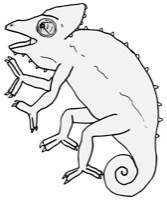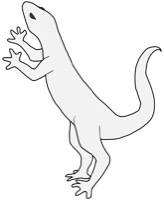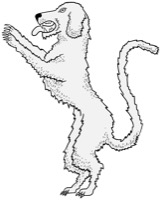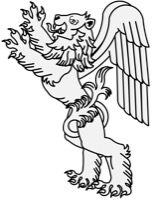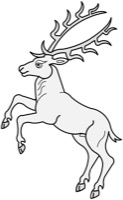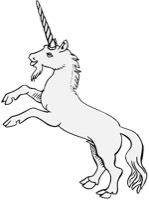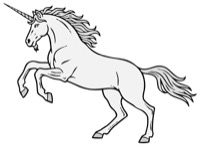50 Entries • Display: Details | Items
Chameleon Salient §
A colorful insectivore.
Default posture: statant. No proper coloration.
Source: Pennsic 50 Art Tent. Artist: Saraswati-mân.ikkam.
Frog Salient §
A leaping amphibian.
Default posture: tergiant. No proper coloration.
Source: Pennsic Bored-Artist Collection. Artist: Imayne de Merlowe.
Lizard Salient §
A small reptile.
No default posture. No proper coloration.
Source: Pennsic 50 Art Tent. Artist: Callum Viktor Sheldon.
Antelope Salient §
A swift hybrid monster similar to a deer but with a tusk on its nose and a lions tail.
No default posture. No proper coloration.
Source: Ortus Sanitatis. Artist unknown.
Armadillo Salient §
An armored beast of the Americas.
No default posture. No proper coloration.
Source: Codex Mendoza. Artist unknown. Adapted by Máel Brigte.
Beaver Salient (1) §
An aquatic mammal that builds dams to aid in fishing.
No default posture. Proper coloration: brown.
Source: Ortus Sanitatis. Artist unknown.
Beaver Salient (2) §
An aquatic mammal that builds dams to aid in fishing.
No default posture. Proper coloration: brown.
Artist: Þórý Veðardóttir. License: CC BY-NC-SA; comercial use requires permision.
Beaver Salient Vorant of a Fish §
An aquatic mammal that builds dams to aid in fishing.
No default posture. Proper coloration: brown.
Artist: Þórý Veðardóttir. License: CC BY-NC-SA; comercial use requires permision.
Domestic Cat Salient §
Dog Salient §
A domesticated canine. Any period breed of dog may be used.
No default posture. No proper coloration.
A hound with hanging ears may be blazoned a “talbot.”
Period scent hound breeds include the bloodhound.
Artist: Ræv Kolfinnsson.
Goat Clymant (1) §
A wild mountainous cousin of the sheep.
No default posture. No proper coloration.
The term “clymant” is used for goats in a rampant posture.
Source: A Complete Guide to Heraldry. Artist: Graham Johnston.
Goat Clymant (2) §
A wild mountainous cousin of the sheep.
No default posture. No proper coloration.
The term “clymant” is used for goats in a rampant posture.
Source: Pennsic Traceable Art. Artist unknown.
Goat Clymant (3) §
A wild mountainous cousin of the sheep.
No default posture. No proper coloration.
The term “clymant” is used for goats in a rampant posture.
Source: Viking Answer Lady SVG Images For Heralds. Artist: Gunnvôr silfrahárr.
Goat Clymant (4) §
A wild mountainous cousin of the sheep.
No default posture. No proper coloration.
The term “clymant” is used for goats in a rampant posture.
Source: Aegidius Tschudi's Armorial. Artist unknown. Adapted by Iago ab Adam.
Goat Clymant (5) §
A wild mountainous cousin of the sheep.
No default posture. No proper coloration.
The term “clymant” is used for goats in a rampant posture.
Source: Stemmario Trivulziano. Artist: Gian Antonio da Tradate. (Arms of di Capris, page 96.)
Goat Clymant (6) §
A wild mountainous cousin of the sheep.
No default posture. No proper coloration.
The term “clymant” is used for goats in a rampant posture.
Source: Priorista di Giuliano de' Ricci. Artist unknown. (Vol. I, folio 57v, arms of Borgo.)
Goat Clymant (7) §
A wild mountainous cousin of the sheep.
No default posture. No proper coloration.
The term “clymant” is used for goats in a rampant posture.
Source: WappenWiki. Artist: Joakim Spuller.
Goat Salient (1) §
A wild mountainous cousin of the sheep.
No default posture. No proper coloration.
The term “clymant” is used for goats in a rampant posture.
Source: Banners, Standards, and Badges. Artist: Thomas Willement.
Goat Salient (2) §
A wild mountainous cousin of the sheep.
No default posture. No proper coloration.
Source: Wellcome Collection. Artist: Abraham de Bruyn. (From an engraving circa 1570.)
Guinea Pig Salient §
A domesticated herbivore of the pre-Columbian Andes.
No default posture. No proper coloration
Artist: Volusia Zoe.
Horse Salient (1) §
A domesticated equine. Presumed to be a stallion unless blazoned a “mare.”
No default posture. No proper coloration.
Source: Wikimedia Commons. Artist: Gustav Völker. License: Public domain.
Horse Salient (2) §
A domesticated equine. Presumed to be a stallion unless blazoned a “mare.”
No default posture. No proper coloration.
Source: Pennsic Traceable Art. Artist unknown.
Jerboa Salient §
Lion Salient (1) §
A fierce cat known as the King of Beasts.
Default posture: rampant. Proper coloration: Or.
Source: Workes of Armorie. Artist: John Bossewell.
Lion Salient (2) §
A fierce cat known as the King of Beasts.
Default posture: rampant. Proper coloration: Or.
Source: A Complete Guide to Heraldry. Artist: Graham Johnston.
Lion Salient (3) §
A fierce cat known as the King of Beasts.
Default posture: rampant. Proper coloration: Or.
Artist: Ræv Kolfinnsson.
Lion Salient Tail Nowed §
A fierce cat known as the King of Beasts.
Default posture: rampant. Proper coloration: Or.
Source: Pennsic Traceable Art. Artist: Roana d’Evreux (attributed).
Winged Lion Salient §
A fierce cat known as the King of Beasts.
Default posture: rampant. Proper coloration: Or.
Source: Viking Answer Lady SVG Images For Heralds. Artist: Gunnvôr silfrahárr. Adapted by Mathghamhain Ua Ruadháin.
Pantheon Salient §
A heraldic monster with a deer-like body, a fox tail, and a smattering of stars.
No default posture. No proper coloration.
Artist: Volusia Zoe.
Rabbit Salient (1) §
A gentle and prolific beast. May be blazoned a "hare" or "coney."
Default posture: sejant. Proper coloration: brown.
Source: Pennsic Traceable Art. Artist unknown.
Rabbit Salient (2) §
A gentle and prolific beast. May be blazoned a "hare" or "coney."
Default posture: sejant. Proper coloration: brown.
Source: A Complete Guide to Heraldry. Artist: Graham Johnston.
Rabbit Salient (3) §
A gentle and prolific beast. May be blazoned a "hare" or "coney."
Default posture: sejant. Proper coloration: brown.
Source: Livro do Armeiro-Mor. Artist: Jean Du Cros. (Arms of Tarse, folio 13v.)
Rabbit Salient (4) §
A gentle and prolific beast. May be blazoned a "hare" or "coney."
Default posture: sejant. Proper coloration: brown.
Source: Two Tudor Books of Arms. Artist: Robert Cooke. (From page 5, arms of Roy de Tace.)
Three Rabbits Salient Conjoined §
A gentle and prolific beast. May be blazoned a "hare" or "coney."
Default posture: sejant. Proper coloration: brown.
Source: Two Tudor Books of Arms. Artist: Robert Cooke. (Page 68.)
Ram Clymant (1) §
A male ovine, or sheep.
No default posture. No proper coloration.
Source: Necrologium Minoritarum Ratisponensium. Artist unknown. (Page 56.) Adapted by Malyss Makneile.
Ram Clymant (2) §
A male ovine, or sheep.
No default posture. No proper coloration.
Source: A Complete Guide to Heraldry. Artist: Graham Johnston.
Sheep Salient §
A fluffy ungulate. A male sheep is blazoned a "ram", while a female may be blazoned a "ewe."
No default posture. No proper coloration.
Source: Pennsic Heralds’ Point Artists. Artist unknown. Adapted by Mathghamhain Ua Ruadháin.
Stag Springing (1) §
A male deer. May also be blazoned a “buck” or “hart.”
No default posture. Proper coloration: brown.
The term “springing” is a synonym for “salient” that is applied to deer.
Source: Pennsic Traceable Art. Artist unknown.
Stag Springing (2) §
A male deer. May also be blazoned a “buck” or “hart.”
No default posture. Proper coloration: brown.
The term “springing” is a synonym for “salient” that is applied to deer.
Source: Viking Answer Lady SVG Images For Heralds. Artist: Gunnvôr silfrahárr.
Stag Springing (3) §
A male deer. May also be blazoned a “buck” or “hart.”
No default posture. Proper coloration: brown.
The term “springing” is a synonym for “salient” that is applied to deer.
Source: Viking Answer Lady SVG Images For Heralds. Artist: Gunnvôr silfrahárr. Adapted by Mathghamhain Ua Ruadháin.
Stag Springing Regardant §
A male deer. May also be blazoned a “buck” or “hart.”
No default posture. Proper coloration: brown.
The term “springing” is a synonym for “salient” that is applied to deer.
Artist: Jon Chesey. Adapted from Anton Tirol's Wappenbuch (German, c. 1540).
Tyger Salient §
A fast-running heraldic beast with the body of a wolf, the tail of a lion, and a downwards-pointed horn on its nose.
No default posture. No proper coloration.
Source: Heraldic Templates. Artist: Torric inn Björn. Adapted by Mathghamhain Ua Ruadháin.
Tyger Salient Regardant §
A fast-running heraldic beast with the body of a wolf, the tail of a lion, and a downwards-pointed horn on its nose.
No default posture. No proper coloration.
Source: Heraldic Templates. Artist: Torric inn Björn. Adapted by Mathghamhain Ua Ruadháin.
Tyger Salient Regardant Incensed §
A fast-running heraldic beast with the body of a wolf, the tail of a lion, and a downwards-pointed horn on its nose.
No default posture. No proper coloration.
The term “incensed” signifies that it has flames emerging from its mouth and ears..
Source: Heraldic Templates. Artist: Torric inn Björn.
Unicorn Salient (1) §
A mythical goat-like (or sometimes horse-like) creature with a beard and a single horn.
Default posture: rampant. No proper coloration.
The Continental unicorn looks more like a goat than a horse.
Source: Banners, Standards, and Badges. Artist: Thomas Willement.
Unicorn Salient (2) §
A mythical goat-like (or sometimes horse-like) creature with a beard and a single horn.
Default posture: rampant. No proper coloration.
Artist: Michael der Gross von Bergen.
Wildcat Salient Guardant Collared and Lined §
An un-domesticated feline. Sometimes blazoned a “cat-a-mountain.”
No default posture. No proper coloration.
Source: Fictitious & Symbolic Creatures in Art. Artist: John Vinycomb.
Wolf Salient (1) §
A wild canid.
No default posture. No proper coloration.
Source: A Complete Guide to Heraldry. Artist: Graham Johnston.
Wolf Salient (2) §
Lamia Salient Guardant §
A hybrid monster formed of a lion with the head and bosom of a woman, the rear legs of a goat, and the tail of a horse.
No default posture. No proper coloration.
Source: Fictitious & Symbolic Creatures in Art. Artist: John Vinycomb.

